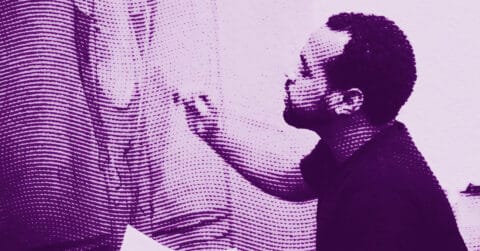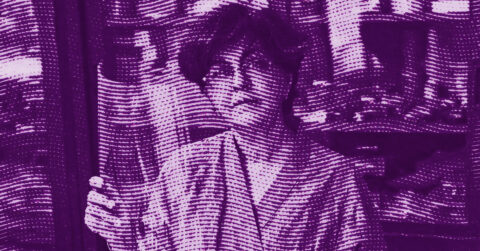Listen to me carefully, you bunch of snobs, it’s time to talk about Pam Evelyn (born in 1996 in Surrey, UK), this pictorial whirlwind shaking the contemporary art world with the force of a typhoon. At just 28 years old, she offers us a masterful lesson on what it means to paint in the 21st century. Forget your prejudices about young artists, this one is different.
The first thing that strikes one about her work is this almost supernatural ability to transform painting into a living force. Her canvases are not mere flat surfaces covered with pigments; they breathe, sweat, vibrate with an intensity reminiscent of Walter Benjamin’s descriptions of the aura of artworks. But beware, do not be mistaken: this is not simply an heir to American abstract expressionism. No, Evelyn does something much more radical, more contemporary, more urgent.
The first theme that emerges from her work is this visceral relationship with the materiality of painting. In “Hidden Scene” (2022), a monumental triptych, Evelyn does not just paint; she orchestrates a real battle between surface and depth. The strips of raw canvas, dotted with black marks, are not simply affixed to the surface; they create a palpable tension with the underlying kaleidoscopic composition. It’s as if Maurice Merleau-Ponty had taken painting lessons; the phenomenology of perception takes here a tangible, almost brutal form.
This approach to materiality reminds us of what Roland Barthes wrote about the “texture of the real,” except that Evelyn pushes the concept even further. She does not merely suggest texture; she literally creates it, layer by layer, in a process that can take up to six months for a single canvas. It is an approach that echoes Gilles Deleuze’s theories on fold and unfold, but translated into a resolutely contemporary pictorial language.
The second theme running through her work is her relationship with time and movement. Take “Deluge” (2023), where the surface of the painting becomes the stage for a storm of brush marks in primary colors raining down like confetti on a dark and battered background. This work is reminiscent of Henri Bergson’s reflections on pure duration, lived time rather than measured time. But whereas Bergson theorized, Evelyn materializes.
What is fascinating about her is her ability to transform the act of painting into a kind of existential performance. Each canvas becomes a battleground where a struggle plays out between control and chaos, between intention and accident. And unlike some contemporary painters who merely recycle gestures from post-war abstraction, Evelyn invents her own pictorial language.
In “Traced Train Windows” (2023), she captures the experience of traveling by train, but not in a literal way. No, she conveys the very sensation of movement, the way the landscape distorts and blurs through a greasy window. This is pure Henri Lefebvre, a production of space that does not just represent, but truly creates a new spatial reality.
What I particularly like is how she uses format. Her canvases are not simply large; they are ambitious. When she creates diptychs nearly 5 meters wide, it is not for mere spectacle. No, it is because her pictorial language demands that space to fully unfold. It’s as if she instinctively understood what Robert Morris theorized in his “Notes on Sculpture,” the importance of scale in our physical experience of art.
And let’s talk about her palette, those warm blues clashing with frog greens, those yellows emerging like flashes in a stormy sky. It’s as if she has digested the entire history of color in modern art, from Turner to Howard Hodgkin, to create something resolutely personal. She does not paint to please; she paints to shake our certainties about what painting can be today.
Her residency work at the Porthmeor studios in Cornwall in 2022 marks a decisive turning point. Facing the raging sea and violent winds, she developed an even more physical approach to painting. The natural elements became not only a source of inspiration but almost collaborators in the creative process. It is fascinating to see how she transformed this experience into something deeply personal while maintaining a critical distance that prevents her work from falling into the trap of easy romanticism.
In “Mirage, A Glaze of Mischief” (2023), she achieves something truly extraordinary: transforming an ephemeral phenomenon, a fleeting play of light, into something permanent and tangible through the thickness of the paint. The luminescent brushstrokes spreading from the top of the canvas, before clinging, bending, and fragmenting, create a dizzying sensation of frozen movement. It’s as if she succeeded in capturing the very essence of what Maurice Blanchot called “the instant.”
What truly sets Evelyn apart from her contemporaries is her stubborn refusal to settle for easy solutions. Where other young artists are content to reproduce tried-and-true formulas, she constantly pushes the boundaries of what painting can be. Her process often involves the partial destruction of her works, a deliberate act of “sabotage” reminiscent of Georges Bataille’s theories on expenditure and excess.
But be careful, do not be mistaken, this apparent violence in her process is not gratuitous. Every gesture, even the most destructive, is part of a broader investigation into the possibilities of contemporary painting. It is a bit like she is putting into practice Jacques Derrida’s theories on deconstruction, but with brushes and oil paint rather than with words.
The way she works with time is particularly fascinating. Her canvases are not simply the result of a linear process, but rather an accumulation of moments, decisions, regrets. It’s as if she creates layered works, where each layer of paint carries the memory of previous gestures. This approach echoes Paul Ricoeur’s reflections on temporality and narration, but translated into a visual language of rare power.
What is remarkable is that at only 28 years old, she has already developed an artistic voice of astonishing maturity. Her works are not merely beautiful or impressive; they are necessary. Her recent showing at the Pace gallery is not a surprise, it was time for the institutional art world to recognize her talent. But Pam Evelyn is not an artist who will be easily tamed by the market. Her work retains a roughness, an intensity that defies easy commodification.
Evelyn’s true strength is that she creates works that operate simultaneously on multiple levels. Her paintings are both deeply intellectual and viscerally physical, historically aware and resolutely contemporary. She achieves a rare tour de force: creating art that speaks as well to the senses as to the mind. Pam Evelyn represents something rare: an unwavering faith in the possibilities of painting as a means of exploration and discovery. Her work reminds us that art is not dead; it is more alive than ever, provided we have the courage to push its limits.
















